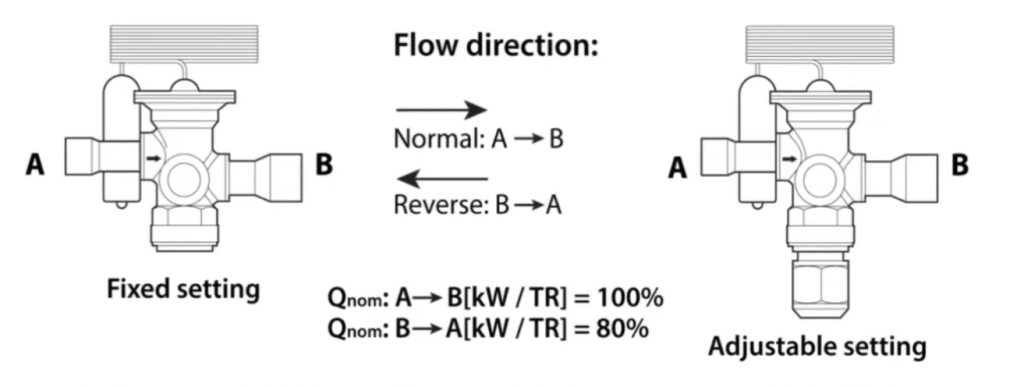Get Tech Tips
Subscribe to free tech tips.
Setting and Adjusting Superheat on a TXV System
This is a quick tip from the “Expansion Valves – What Does and Doesn't Matter?” livestream on our YouTube channel featuring Joe Shearer, Matthew Taylor, and Corey Cruz.
As metering devices, TXVs can adjust the size of their orifice to maintain a constant superheat. Some TXVs are set to maintain a specific superheat from the factory, but a few are adjustable. When you come across these adjustable valves, you can use a service wrench to loosen or tighten a stem that controls the spring pressure (a closing force from the bottom of the valve). The change in spring pressure will raise or lower the superheat that the TXV tries to maintain.
However, there are a few things to keep in mind before you go about setting and adjusting your superheat on a TXV.
Know if the Valve is Adjustable
In several (but not all!) commercial refrigeration systems that use TXVs, the valve will be adjustable.
Adjustable valves will look different from fixed valves. TXVs that can’t be adjusted will be flat on the bottom. Adjustable ones will have an extension; it’s a nut that covers an adjustable stem, and you can twist it off to expose the stem.

Attempting to adjust a non-adjustable valve may cause the system charge to leak out. On a large refrigeration system, the consequences could be catastrophic, so make sure you can adjust the TXV before you grab your wrench.
Do You NEED to Adjust It?
When the superheat is out of the manufacturer’s range at the evaporator outlet, you ought to consider all other options before adjusting the stem. Before you grab a service wrench, ask the following questions:
- Is the bulb making good contact with the suction line and NOT mounted at 6 o’clock?
- In commercial HVAC/R systems with mechanical subcooling, is the mechanical subcooler working properly?
- Are the load conditions appropriate for the system capacity (i.e., is the airflow sufficient?)?
- Are there restrictions (from dirty filter driers and TXV screens, etc.)?
Rule out all other possible operational issues before adjusting the TXV. Adjusting the TXV manually to open it more without addressing the main issues makes floodback a lot more likely. When someone finally fixes the operational issue, that valve will slam open and allow too much liquid refrigerant to enter the evaporator and get into the compressor, which will lead to failure.
Adjusting the TXV
To adjust the TXV, remove the nut covering the adjustable stem. First, make sure you have the manufacturer’s instructions at the ready. Those instructions will let you know how much you need to rotate the stem to make fine adjustments.
Then, figure out if you need to increase or decrease the superheat. You can either increase the superheat by turning your service wrench clockwise or decrease it by turning your wrench counterclockwise. Turn only ½ turn at a time.
Since the stem directly connects to the spring, you’re raising or lowering that spring, which affects the closing pressure from the bottom. Loosening the stem will back the spring out, which decreases the superheat by allowing more liquid to flow through the valve. Tightening the stem will increase the superheat by creating a smaller orifice and letting less liquid into the evaporator.
Any time you make an adjustment, run the system with all the panels on, completely buttoned up. Measure your superheat again and then make further adjustments if necessary. It’s important to test the equipment under typical operating conditions—expected airflow and all—and not to take shortcuts.
Repeat the process as needed until you reach the maximum setting. NEVER force the adjustment screw too far; it should require minimal force to turn other than possibly initially to “unstick” the screw.
You can watch THIS video for a visual demonstration.
When Should I Adjust the TXV?
Adjusting the TXV is more common in mission-critical commercial HVAC/R systems. It’s not something any of us should be afraid of doing, but we need to make sure we’re doing it only when it’s necessary.
Keep in mind that adjusting the TXV too much—either repeatedly over time or too roughly—can cause the adjustment stem to strip out. The valve will remain in that position fully, making it unable to be adjusted ever again. At that point, you would need to replace the valve.

Conclusion
Adjusting the TXV is a task that’ll eventually come up for techs in all corners of the HVAC/R world—residential, light commercial, and heavy commercial. But it’s usually not the first solution we should consider.
If you come across a system with improper superheat, make sure to explore all other possible causes before grabbing your wrench to adjust the TXV. Oh, and be sure that the valve is adjustable in the first place. The last thing any of us would want is to put a wrench on a non-adjustable TXV and release the entire refrigerant charge. (That’s a bad day.)











Comments
To leave a comment, you need to log in.
Log In